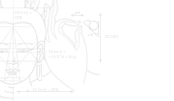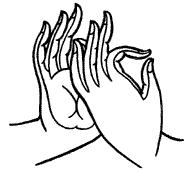 |
|
|
| |
||
| |
|
|
| |
||
|
|
||
| |
||
No representations of the Buddha were made for about four or five centuries after the death of the Buddha. It is sometimes said that prior to this time it was 'forbidden' to make statues or pictures of the Buddha. Whatever the reasons, the first Buddha statues were produced in about the 1st or 2nd century AD in Bactria (Afghanistan and northern Pakistan) perhaps as a result of Greek influence, and in Mathura. There is no standard way of representing the Buddha which may differ according to the artistic inspiration, the tastes or the iconographical canons of the different cultures in which they are produced. Some features however are common to most statues. The hands of the Buddha statues are shown in different gestures (mudra), each indicative of important things the Buddha did throughout his life.
The gesture of teaching or Dhammacakra mudra with both hands in front of the chest, with the right hand raising the tips of the index finger and the thumbs touching; and with the left hand raising the tips of the ring finger and the thumbs touching has its special significance in the history of the Buddhist art. This pose of the Buddha, the Dhammacakra mudra, appears to have existed from the beginning of the history of Buddhist art as can be seen early in the Gandhara period. However, the placing of the hands gesture is not always the same in all Buddhist countries, cultures and periods. There is no universal standard of this gesture. Nevertheless, the fundamental character is that one or both hands are raised with the one of the hand's forefinger touching the thumb, making the shape of a circle and leaving three fingers straight. This could be both in a standing or sitting pose. Despite recognising this hand gesture as teaching the exact meaning of this symbol varies. It differs from culture to culture or according to artistic views. Following are some explanations available from different sources: a) It symbolises the main principle of Buddhism viz. the Threefold Training (i.e. precept, mental-development and wisdom) that leads to the ultimate aim of Buddhist emancipation, Nibbana. Raising three fingers represent the Threefold Training and the circle symbolises Nibbana. b) It represents the Threefold Training summarised in the Middle Path. c) It symbolises the setting of the wheel of Dhamma in motion for the happiness and benefits of all beings living in three spheres (viz. the Sense-sphere, the Form-sphere and the Formless-sphere). d) It signifies the essence of the Discourse on Setting in Motion the Wheel of Dhamma (Dhammacakkappavattana Sutta), the First Sermon of the Buddha. Raising three fingers implies the Three Paths viz. the Path of Self-indulgence, the Path of Self-mortification, and the Middle Path or the Eightfold Noble Path. It draws upon the instruction that one should avoid the Path of Self-indulgence and Path of Self-mortification but should follow the Middle Path that leads followers to final liberation or Nibbana. In the creation of the Phra Buddha Dhammacakra image, the sculptor brought together the original Gandhara artistic style of the teaching pose applied with Sukhothai and modern Ratanakosin arts of Thailand. The image is cast in bronze with the mixture of pure gold. It is made by the 'lost wax process', where a wax image is created, then coated with a plasticine based mould which is subsequently baked allowing the wax to melt and drain away, replacing it with molten metal. The finished image is then gilded and adorned with pure gold leaf. The Dhammacakra mudra pose indicates the event when the Buddha gave the First Sermon after his enlightenment to the Five Ascetics at Isipatana deer park near Varanasi, seven weeks after his enlightenment. The discourse was named Dhammacakkappavattana Sutta or discourse on setting the wheel of Dhamma in motion. It is often
said that Buddhists worship statues, in the sense that they
believe that Buddha statues actually are the Buddha or that
they have some inherent power. But such ideas are quite incorrect.
Buddhists do not 'worship' Buddha statues but they are seen
as symbols that can be helpful in creating devotion, uplifting
the mind and focusing attention. In particular, they represent
the absolute virtues of the Buddha, which Buddhists recite to
remind themselves of such virtues and to gain inspiration to
develop those virtues within themselves. |
||||||
| |
|||||||
| |
|||||||
| |
Copyright © 2008 - BDEA Inc. & BuddhaNet. All rights reserved. | |
|
|
|
|
|
| |
|||||||
| |
|||||||


 The
hands nestled in the lap suggest meditation, held in front of
the chest suggest teaching the Dhamma, one hand held up with
the palm facing outwards suggests the giving of confidence or
fearlessness, etc.
The
hands nestled in the lap suggest meditation, held in front of
the chest suggest teaching the Dhamma, one hand held up with
the palm facing outwards suggests the giving of confidence or
fearlessness, etc.